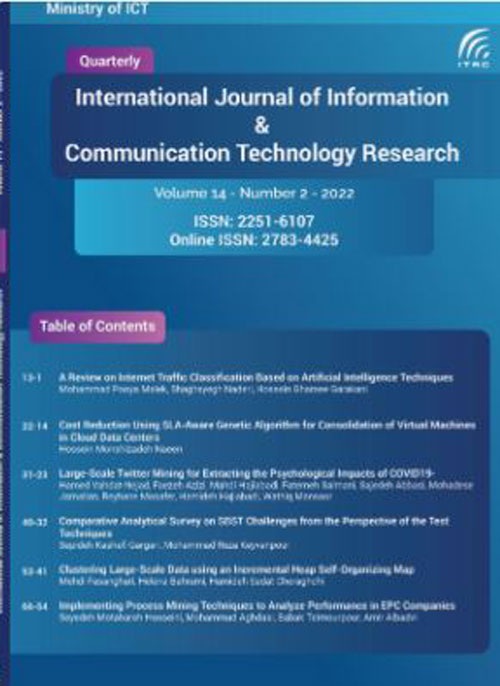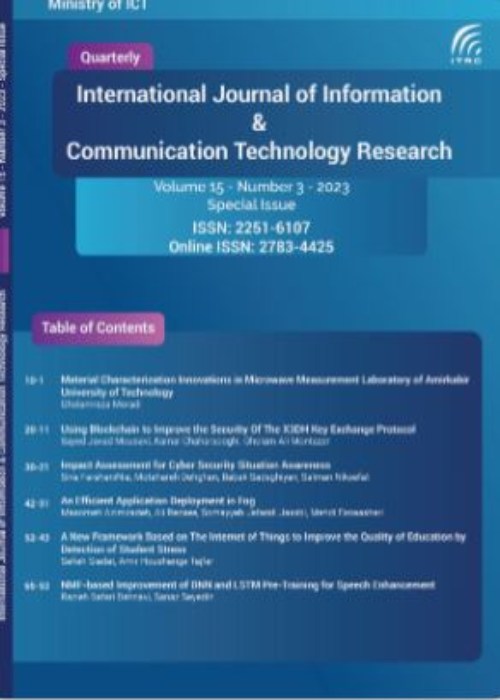فهرست مطالب

International Journal Information and Communication Technology Research
Volume:14 Issue: 2, Spring 2022
- تاریخ انتشار: 1401/06/20
- تعداد عناوین: 6
-
-
Pages 1-13
Almost every industry has revolutionized with Artificial Intelligence. The telecommunication industry is one of them to improve customers' Quality of Services and Quality of Experience by enhancing networking infrastructure capabilities which could lead to much higher rates even in 5G Networks. To this end, network traffic classification methods for identifying and classifying user behavior have been used. Traditional analysis with Statistical-Based, Port-Based, Payload-Based, and Flow-Based methods was the key for these systems before the 4th industrial revolution. AI combination with such methods leads to higher accuracy and better performance. In the last few decades, numerous studies have been conducted on Machine Learning and Deep Learning, but there are still some doubts about using DL over ML or vice versa. This paper endeavors to investigate challenges in ML/DL use-cases by exploring more than 140 identical researches. We then analyze the results and visualize a practical way of classifying internet traffic for popular applications.
Keywords: Internet Traffic Classification, Network Traffic Analysis, DL, ML, Artificial intelligence -
Pages 14-22
Cloud computing is a computing model which uses network facilities to provision, use and deliver computing services. Nowadays, the issue of reducing energy consumption has become very important alongside the efficiency for Cloud service providers. Dynamic virtual machine (VM) consolidation is a technology that has been used for energy efficient computing in Cloud data centers. In this paper, we offer solutions to reduce overall costs, including energy consumption and service level agreement (SLA) violation. To consolidate VMs into a smaller number of physical machines, a novel SLA-aware VM placement method based on genetic algorithms is presented. In order to make the VM placement algorithm be SLA-aware, the proposed approach considers workloads as non-stationary stochastic processes, and automatically approximates them as stationary processes using a novel dynamic sliding window algorithm. Simulation results in the CloudSim toolkit confirms that the proposed virtual server consolidation algorithms in this paper provides significant total cost savings (evaluated by ESV metric), which is about 45% better than the best of the benchmark algorithms.
Keywords: component, Cloud Computing, Green IT, SLA violation, VM Consolidation, Genetic Algorithms -
Pages 23-31
The outbreak of the COVID-19 in 2020 and lack of an effective cure caused psychological problems among humans. This has been reflected widely on social media. Analyzing a large number of English tweets posted in the early stages of the pandemic, this paper addresses three psychological parameters: fear, hope, and depression. The main issue is the extraction of the related tweets with each of these parameters. To this end, three lexicons are proposed for these psychological parameters to extract the tweets through content analysis. A lexicon-based method is then used with GEO Names (i.e. a geographical database) to label tweets with country tags. Fear, hope, and depression trends are then extracted for the entire world and 30 countries. According to the analysis of results, there is a high correlation between the frequency of tweets and the official daily statistics of active cases in many countries. Moreover, fear tweets dominate hope tweets in most countries, something which shows the worldwide fear in the early months of the pandemic. Ultimately, the diagrams of many countries demonstrate unusual spikes caused by the dissemination of specific news and announcements.
Keywords: natural language processing, emotion analysis, knowledge extraction, data mining -
Pages 32-40
Despite several decades of working on software quality assurance methods, they still require further investigation. It is paramount to detect a process detecting possible software errors with a minimum budget and effort. Search-based software testing (SBST) is an approach to automated software testing that aims to find a suitable alternative to manual testing. The SBST is to transform the test problem into an optimization problem and obtain better solutions by searching the problem space. Search-based testing has some disadvantages and advantages. The novelty of this paper is that, besides representing the significance and efficiency of SBST in software testing, the search-based test challenges were detected and described from the perspective of the test techniques. Our work is to extract challenges from reliable sources and research and their classification based on test techniques. For this purpose, we considered this framework: 1) A systematic introduction to the most critical metaheuristic optimization algorithms. 2) classifying the test techniques and explaining their advantages and disadvantages. 3) proposing a suitable classification for the challenges of the search-based test area based on the technique used. Our motivation to do this research was to provide complete knowledge about search-based software testing challenges so that new researchers could choose their research fields with prior knowledge and provide a way to improve existing methods. Finally, the results of this paper can be used to compare the existing test techniques used in SBST, select the best one, and represent the challenges of each technique.
Keywords: SBST challenges, problems, test case generation, search-based software testing -
Pages 41-53
In machine learning and data analysis, clustering large amounts of data is one of the most challenging tasks. In reality, many fields, including research, health, social life, and commerce, rely on the information generated every second. The significance of this enormous amount of data in all facets of contemporary human existence has prompted numerous attempts to develop new methods for analyzing large amounts of data. In this research, an Incremental Heap Self-Organizing Map (IHSOM) is proposed for clustering a vast amount of data that continues to grow. The gradual nature of IHSOM enables environments to change and evolve. In other words, IHSOM can quickly adapt to the size of a dataset. The heap binary tree structure of the proposed approach offers several advantages over other structures. Initially, the topology or neighborhood relationship between data in the input space is maintained in the output space. The outlier data are then routed to the tree's leaf nodes, where they may be efficiently managed. This capability is supplied by a probability density function as a threshold for allocating more similar data to a cluster and transferring less similar data to the following node. The pruning and expanding nodes process renders the algorithm noise-resistant, more precise in clustering, and memory-efficient. Therefore, heap tree structure accelerates node traversal and reorganization following the addition or deletion of nodes. IHSOM's simple user-defined parameters make it a practical unsupervised clustering approach. On both synthetic and real-world datasets, the performance of the proposed algorithm is evaluated and compared to existing hierarchical self-organizing maps and clustering algorithms. The outcomes of the investigation demonstrated IHSOM's proficiency in clustering tasks.
Keywords: Self-organizing map (SOM), Binary heap tree, Incremental hierarchical structure, Probability density function -
Pages 54-66
The importance of process analysis in engineering, procurement and construction companies (EPC), due to the complexity of the measures, the high level of communication between people, different and non-integrated information systems, as well as the amount of capital involved in these projects is much higher and more challenging. Limited research has been done on exploring business processes in these companies. In this study, in order to better and more accurately analyze the company's performance, three perspectives of process mining (process flow, case and organizational) is analyzed by using the event logs recorded in the supplier selection process. The results of this study led to the identification of challenges in the process, including repetitive loops, duplicate activities, survey of factors affecting the implementation of the process and also examining the relationships between people involved in the project, which can be used to improve the future performance of the company.
Keywords: Process Mining, Process Mining perspectives, Complex Construction Project Management, EPC Companies


